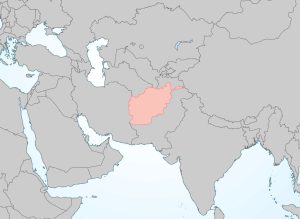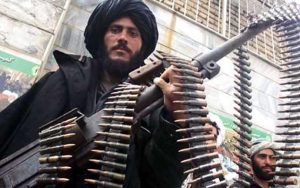85 Central Asia: Political Geog I – Where Empires Go to Die
“Fool!” cried the hunchback. “You fell victim to one of the classic blunders.
The most famous is ‘Never get involved in a land war in Asia,’ but only slightly less well known is this:
‘Never go in against a Sicilian when death is on the line.’”
- as stated by the character Vizzini, played by Wallace Shawn in the movie
― William Goldman, The Princess Bride
In 2012, the United States’ war in Afghanistan entered its eleventh painful year, making it the longest war in American history. Many Americans began to refer to Afghanistan as “a place where empires go to die,” and their pessimism was not unjustified – the war would drag on for nearly another decade. In reality, though, not all invasions of Afghanistan have proven unsuccessful. The Greeks, Huns, Arabs, Mongols, Turks, and Persians are just a few of the groups who have invaded Afghanistan, conquered it, and ruled it for years. Afghanistan’s reputation as graveyard of empires largely evolved over the last century and a half. Since the mid-1800s, three of the world’s superpowers have led disastrous wars in Afghanistan. In this chapter, we will examine the reasons why Great Britain, the Soviet Union, and the United States invaded this poor, rugged, landlocked country, and why all of three of them ultimately failed to conquer it.
The Anglo-Afghan Wars
In mid-1800s, Britain was undertaking its conquest of South Asia, which it would rule for nearly a century. At the time, the British were wary of Afghanistan. A number of Afghan rulers had raided India over the centuries, and Britain wanted to eliminate any possible threats to their new colony. At the same time, the Russian Empire was expanding into Central Asia. The British feared that Afghanistan would soon fall to Russian invasion, potentially bringing the two European empires into conflict.
Britain first invaded Afghanistan in 1839, and controlled it for a few years. Facing escalated violence, however, British troops were withdrawn in 1843. Russian influence subsequently increased in Afghanistan, and Britain invaded the country again in 1878, installing a puppet government. British troops would remain in the country for forty years.
After the war, British and Russian diplomats worked to settle the current boundaries of Afghanistan, solidifying plans and the borders in 1893 and 1895. A small strip of land was designed to be a neutral buffer state between the two great empires, a fact that is still apparent on modern maps. The Wakhan Corridor, a narrow strip of territory in Afghanistan’s east that runs all the way to China, guaranteed that British India and Russian Central Asia would not share so much as an inch of border with one another. Read more about this in Chapter 88.
A third Anglo-Afghan War erupted in 1919, when Afghanistan’s pro-British ruler was assassinated. Britain, exhausted by World War I, eventually agreed to withdraw from the country, and Afghanistan’s sovereignty was fully restored. The new Afghan government sought to establish friendly relations with Russia as protection against future British encroachment. In 1921, Afghanistan would become one of the first countries to officially recognize Russia’s new communist government. Afghanistan did not itself embrace communism (at least, not yet), but it refused to align with the United States during the Cold War, which was key to the Soviets in securing their Central Asian frontier.
The Soviet-Afghan War

Cartography by Steve Wiertz.
Some of the staunchest Afghan allies of the Soviet Union were communist members of the country’s military. When Afghanistan’s central government weakened in the 1970s, those officers staged a military coup. The new communist government, which was aided by the Soviet Union, was almost immediately and universally reviled by the Afghan people. Thousands of business owners and religious leaders were imprisoned, tortured, and killed. Afghanistan’s deeply conservative rural population were never fond of a strong central government. They certainly wouldn’t tolerate one that attacked their religious leaders, and that threatened to confiscate their land. Soon, Afghanistan’s communist rulers were facing a nationwide rebellion.
In 1979, the Soviet Union invaded Afghanistan, overthrew its government, and established its own communist puppet regime. In Moscow, Soviet leaders believed it would be a brief military action, hoping that any rebellions would be handled the Afghan army. Instead, the situation quickly devolved into what many call the “Soviet Vietnam.” The Soviet military established control over Kabul and most other major cities, but the vast majority of the countryside was never fully under government authority. Afghan militias, known as the mujahideen, began to mount an armed resistance. The Soviets contained this insurgency for quite some time, using attack helicopters to seek out and destroy mujahideen positions. Over time, though, the mujahideen began to receive weapons and training from the United States. Afghanistan was now a battleground of the Cold War. Armed with shoulder-fired, American-made, surface-to-air missiles, the mujahideen began to bring down Soviet helicopters by the dozen. The Soviets were forced to commit more resources to ground troops, and the conflict became extremely deadly for both sides.
The war would drag on for a decade, with the Soviet Union finally withdrawing from the country in 1989. Nearly 15,000 Soviet soldiers were killed. Estimates of Afghans killed in the fighting vary widely. The mujahideen lost between 50,000 and 200,000 fighters. Civilian deaths numbered between 500,000 and 2,000,000. If the higher estimates are true, then more than 15% of Afghanistan’s population died in the conflict. Additionally, nearly a third of the country’s civilian population fled into neighboring Pakistan and Iran during the war.
The Afghanistan War

Photo by Andre Klimke on Unsplash.
After the Soviet withdrawal, the communist Afghan government’s days were numbered. In 1992, the mujahideen seized Kabul and overthrew the government. With the elimination of their common enemy, however, the mujahideen coalition began to fragment. Eventually, the country shattered along ethnic lines and plunged into civil war. By 1996, a group known as the Taliban was able to seize control of most of the country’s territory. The Taliban was an extraordinarily conservative Islamist militia, made up mainly of Pashtuns, Afghanistan’s largest ethnic group. Independence from and opposition to Taliban rule was mainly limited to Tajiks and Uzbeks in the country’s far north, who formed a coalition known as the Northern Alliance.
Once in control of Afghanistan’s government, the Taliban imposed their extremist vision of Islam on the country. Girls were no long allowed to receive an education, and women were no longer allowed to work outside the home. Women were required to be fully covered in public, and to be accompanied by a male relative. The Taliban destroyed priceless cultural artifacts and structures that were considered “un-Islamic” and banned all “un-Islamic” practices, such as playing musical instruments, watching television, trimming beards – even flying kites. The Taliban were condemned for massive human rights violations, particularly against ethnic minorities and women, and frequently executed anyone who opposed their rule.
The Taliban also provided safe haven for al-Qaeda, an international Islamist terrorist organization led by Osama bin Laden, a Saudi national. Bin Laden was among a number of Arabs who had come to Afghanistan to fight against the Soviet Union, and who received weapons and training from the United States. In the 1990s, bin Laden recruited and trained thousands of Afghan and Arab fighters, and used Afghanistan as a base of operations from which to carry out a string of infamous terrorist attacks. These included the attempted assassination of Egypt’s president, the bombing of U.S. military bases and embassies in Saudi Arabia, Kenya, and Tanzania, and the bombing of the USS Cole. Al-Qaeda’s most notorious success was the September 11th, 2001, attack on the Pentagon and World Trade Center in the United States.
In the wake of those attacks, U.S. and British-led NATO forces, coordinating with the Northern Alliance, invaded Afghanistan. Their aim was to destroy al-Qaeda and remove the Taliban from power. The NATO coalition was able to seize Kabul and most of the country’s other major cities within two months. The U.S. declared an end to major combat operations in 2003.
By that time, a pro-Western Afghan government had been formed, and the United States had launched a massive economic rebuilding campaign in Afghanistan. Unfortunately, this rebuilding campaign would be poorly coordinated and badly underfunded, largely because the U.S. had turned its attention to the war in Iraq. The new Afghan government also proved to be unpopular, largely due to incompetence and corruption, but also because it attempted to impose strong centralized rule over rural population.

By 2005, the Taliban had regrouped. They had now learned that traditional battlefield confrontations with NATO forces was a disastrous proposition, so they turned to a guerilla warfare. Aided by militants in rural western Pakistan, they launched an insurgency against the new Afghan military and NATO forces, relying on ambushes, suicide bombings, and improvised explosive devices. Casualties for coalition troops soared, and a decisive victory grew more and more elusive. Like the Soviets before them, the United States and its allies were never able to gain effective control of Afghanistan’s countryside.
U.S. and other NATO forces would remain in the country for two decades, slowly withdrawing their forces over the last several years of the war. In 2014, all British and American bases were handed over to the Afghan military. In 2021, the United States began to withdraw the last of its troops, hoping that the Afghan military would be able to beat back Taliban advances. Many members of the Afghan military, knowing that was extremely unlikely, and knowing that they would be killed if captured, removed their uniforms, dropped their weapons, and simply walked away from the conflict. The Taliban made lightning-fast advances across the country, capturing one city after another. In the final chaotic days of the war, the remaining Americans were airlifted out of Kabul, and the Taliban returned to power. More than 55,000 Taliban and al-Qaeda militants were killed during the war. NATO-aligned Afghan military and security forces suffered 70,000 deaths. The NATO coalition lost more than 3,500 personnel, including 2,400 Americans. An estimated 46,000 civilians were also killed during the conflict.
Did you know?
Frederick Forsyth’s 2007 fictional novel “The Afghan” accurately describes the historical background of wars in Afghanistan.
My Turn!
CITED AND ADDITIONAL BIBLIOGRAPHY:
Klimke, Andre. Apache Attack Helicopter in Approach in Afghanistan. Unsplash. 18 October 2020, https://unsplash.com/photos/-IhgLixx7Z8.
newsonline. Taliban. photo, 11 June 2013. Flickr, https://www.flickr.com/photos/55361146@N08/9019774588/. Attribution 2.0 Generic (CC BY 2.0).
Wiertz, Steve. Afghanistan. College of DuPage GIS Class, May 2022.


